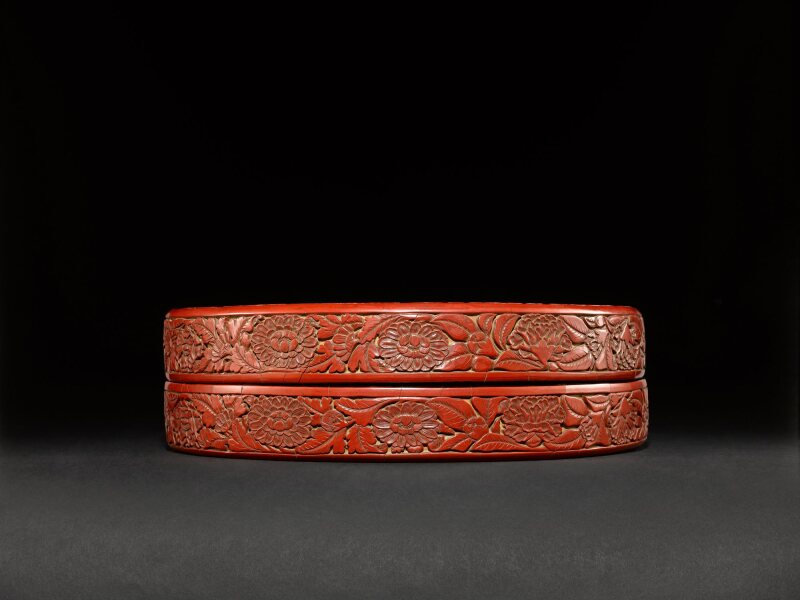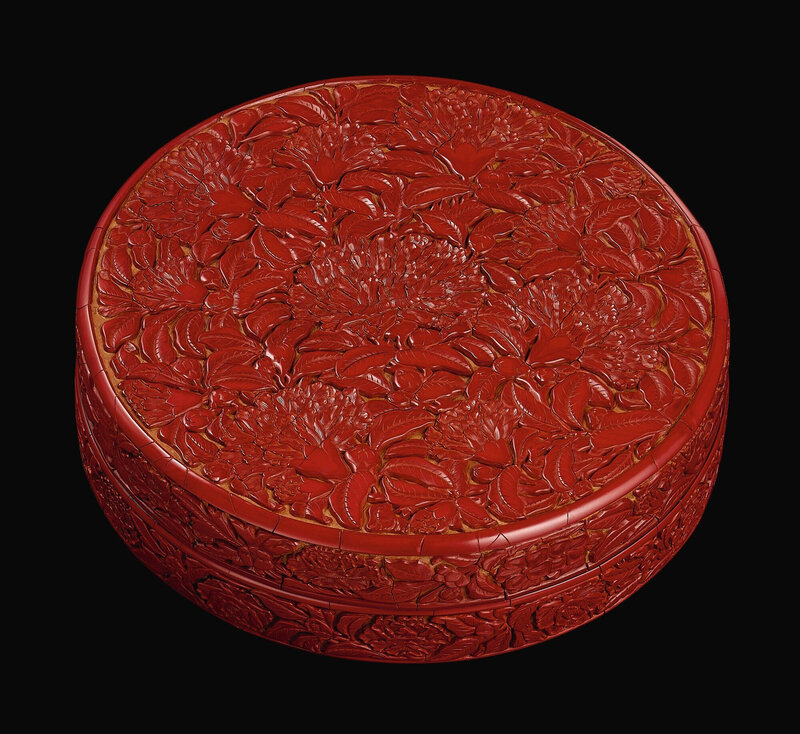A superbly carved large cinnabar lacquer 'peony' box and cover, Mark and period of Yongle
The Personal Collection of the late Sir Joseph Hotung. Lot 5. A superbly carved large cinnabar lacquer 'peony' box and cover, Mark and period of Yongle (1403-1424); d. 31.5 cm, overall h. 9 cm. Lot sold: 7,560,000 HKD (Estimate: 8,000,000 - 12,000,000 HKD). © Sotheby's 2022
of circular form, superbly carved on the top and around the sides through thick layers of red lacquer to reveal the ochre-yellow ground, the flat top carved with five large peony blooms and four smaller ones shown in various stages of maturity and wreathed by dense foliage, the blooms purposefully laid out across the space and detailed with fine and crisply incised veins, the sides of the cover and box bordered by composite floral bands consisting of peonies and chrysanthemums, the interior and base lacquered black, incised with a vertical six-character reign mark on the left side of the base, Japanese wood box.
Provenance: Christie's Hong Kong, 30th April 2001, lot 637 and back cover.
Literature: Giuseppe Eskenazi in collaboration with Hajni Elias, A Dealer's Hand. The Chinese Art World Through the Eyes of Giuseppe Eskenazi, London, 2012; Chinese version, Shanghai, 2015, reprint, 2017, pl. 64
The Perfect Diplomatic Present
Regina Krahl
Red lacquer boxes carved with peonies – among China’s most beloved flowers – belong to the classics of early Ming lacquer ware. The present box with its superbly laid-out and executed lush floral design and impressive size is an exceptionally powerful work of art. Unlike porcelain, carved lacquer ware with its extremely labour-intensive production process, did not lend itself to production in large series and is altogether much rarer; but the carved lacquer craft underwent a similar development as the contemporary porcelain industry. Relentless court intervention and supervision in the Yongle period (1403-24) led to a dramatic increase in quality without stifling artistic ingenuity. Like with blue-and-white porcelain, artists at the Yongle court appear to have refined the designs which were sent to the workshops to manufacture. Many of these Yongle products seem to have been intended not to furnish the imperial palace but to serve as diplomatic gifts to foreign sovereigns. An important Ming document that records presents from the court of the Yongle Emperor to the Ashikaga Shogun of Japan, shows that between 1403 and 1407 the Chinese court sent 203 pieces of carved red lacquer to the Japanese ruler. As auspicious flowers symbolizing wealth and honour, peonies were the perfect design for such gifts.
The wares developed under the Yongle Emperor undoubtedly show the best and most mature lacquer carving style ever developed in China, and the present box is a prime example of this. These cylindrical boxes with their flat round tops covered with horror-vacui designs relentlessly show-case the artisans’ abilities to arrive at a harmonious layout, to balance the criss-crossing layers of leaves with their differently veined upper- and undersides across the circular space, to rhythmically embed blossoms in different stages of maturity among the foliage, and to reveal roughly equal amounts of the yellow base lacquer in between. Yongle lacquer wares are usually so densely filled with motifs that very little of the ground colour is exposed. When the court reclaimed the wares of the imperial workshops more and more for its own use, as we move towards the Xuande period (1426-35), quality remained high but production saw continuity rather than new inspiration, and increased standardization. Boxes of the exceptional size of the present piece seem to have been created almost exclusively in the Yongle period, or even slightly earlier.
A smaller (26.5 cm) lacquer box of Yongle mark and period with a similar peony design differently laid out is in the National Palace Museum, Taipei, from the Qing court collection, with the two smaller blossoms on either side of the present box reduced to buds, taking into account the smaller space; the inside of its cover was in 1782 inscribed with an imperial poem by the Qianlong Emperor (r. 1736-95); see Heguang ticai. Gugong zang qi/Carving the Subtle Radiance of Colors. Treasured Lacquerware in the National Palace Museum, Taipei, 2008, no. 014 (fig. 1). Another Yongle five-peony box of this smaller size was sold in these rooms 7th May 2002, lot 623 and at Christie’s Hong Kong, 27th November 2017, lot 8009.
fig. 1. A carved cinnabar lacquer 'peony' box and cover, Mark and period of Yongle; National Palace Museum, Taipei.
Only few other Yongle boxes are known of the size of the present piece, but carved with different flower designs on top. One such box decorated with chrysanthemums, later inscribed with a Qianlong reign mark, is in the Palace Museum, Beijing, illustrated in The Complete Collection of Treasures of the Palace Museum. Lacquer Wares of the Yuan and Ming Dynasties, Hong Kong, 2006, pl. 46, together with two further boxes of similar diameter, also from the Qing court collection, one decorated with a landscape, the other with Buddhist motifs, pls 44 and 45. A box carved with five camellias on top and bearing a Xuande reign mark is in the National Palace Museum, published in Heguang ticai, op.cit., no. 013; another box carved with only three blooms on the cover, perhaps roses, from the collection of the Nanzen-ji in Kyoto, one of the foremost and oldest Zen temples whose history goes back to the 13th century, was included in the exhibition Tōyō no shikkōgei/Oriental Lacquer Arts, Tokyo National Museum, Tokyo, 1977, cat. no. 504; and a box of this size carved with five pomegranate blossoms was sold in these rooms, 11th July 2020, lot 110.
A superbly carved cinnabar lacquer 'pomegranate' box and cover, Mark and period of Yongle (1403-1425); 31.5 cm, 12 3/8 in. Sold for 15,055,000 HKD at Sotheby's HongKong, 11th July 2020, lot 110. Courtesy Sotheby's.
Smaller peony-decorated boxes with only three main blooms on top (18.5-25 cm) are far more common, both with and without reign marks; for three examples in the Palace Museum, Beijing, see The Complete Collection of Treasures, op.cit., pls 29, 71 and 73; two others in the National Palace Museum, Taipei, are illustrated in Heguang ticai, op.cit., nos 011 and 012.
One even larger box carved with phoenixes among composite flowers on a diaper ground, was presented by Sir Percival David to H.M. The King of Sweden upon the King’s 80th birthday, and is now in the Ostasiatiska Museet, Stockholm (John Figgess, ‘Ming and Pre-Ming Lacquer in the Japanese Tea Ceremony’, Transactions of the Oriental Ceramic Society, vol. 37, 1967-69, pl. 52; and Tōyō no shikkōgei, op.cit., no. 502). This box has later, however, been attributed to the Hongwu reign (1368-98) by Lee King-tsi anHu Shih-chang.
Lee and Hu, both noted lacquer scholars and collectors, who intensively studied early carved lacquer wares, postulated that the production of the superlative lacquer wares carved in this style and bearing Yongle reign marks started already in the Hongwu period (‘Carved Lacquer of the Hongwu Period’ and ‘Further Observations on Carved Lacquer of the Hongwu Period’, Oriental Art, vol. XLVII, no. 1, 2001, pp. 10-20, and vol. LV, no. 3, 2005-6, pp. 41-47, both reprinted in Layered Beauty. The Baoyizhai Collection of Chinese Lacquer, Art Museum, Institute of Chinese Studies, The Chinese University of Hong Kong, Hong Kong, 2010, pp. 171-190). They referred to the gifts from the Yongle Emperor to the Ashikaga Shogun, the most important of which, with fifty-eight pieces, occurred in the first year of the Yongle reign, 1403, and stated that since the complex lacquer production process could take years to complete, this could not have been achieved within a matter of months, and that the pieces the Emperor presented must therefore have been of Hongwu date.
Since many pieces in this list are clearly described, Lee and Hu tried to identify distinguishing features for Hongwu and Yongle wares and proposed that Hongwu flower-decorated pieces typically show flowers of the Four Seasons and have the Yongle reign mark, later inscribed, on the right-hand side of the base, while on actual Yongle pieces the main decoration consists of a single species of flower and the reign mark appears on the left. The Yongle date of the present box thus would be confirmed also by this theory.
Sotheby's. HOTUNG The Personal Collection of the late Sir Joseph Hotung: Part 1, Hong Kong, 8 October 2022

/https%3A%2F%2Fprofilepics.canalblog.com%2Fprofilepics%2F1%2F0%2F100183.jpg)
/https%3A%2F%2Fstorage.canalblog.com%2F03%2F02%2F119589%2F96711876_o.jpg)
/https%3A%2F%2Fstorage.canalblog.com%2F11%2F31%2F119589%2F94773502_o.jpg)
/https%3A%2F%2Fstorage.canalblog.com%2F20%2F83%2F119589%2F94772815_o.jpg)
/https%3A%2F%2Fstorage.canalblog.com%2F26%2F72%2F119589%2F75604929_o.jpg)
/https%3A%2F%2Fstorage.canalblog.com%2F59%2F60%2F119589%2F26458628_o.jpg)








/image%2F1371349%2F20240409%2Fob_73d398_telechargement.jpg)
/http%3A%2F%2Fstorage.canalblog.com%2F86%2F19%2F119589%2F129426368_o.jpg)
/http%3A%2F%2Fstorage.canalblog.com%2F44%2F07%2F119589%2F129425692_o.jpg)
/http%3A%2F%2Fstorage.canalblog.com%2F00%2F88%2F119589%2F129137720_o.jpg)